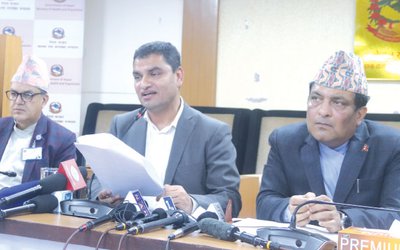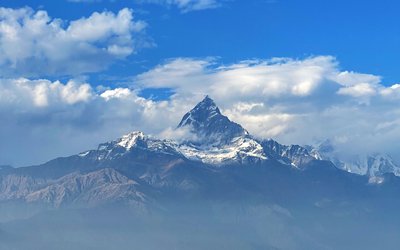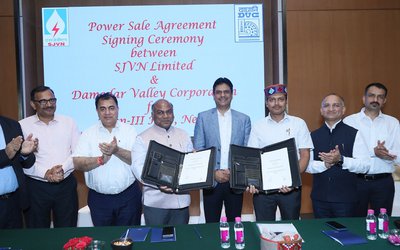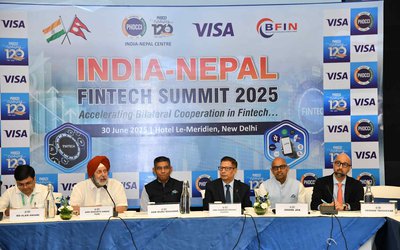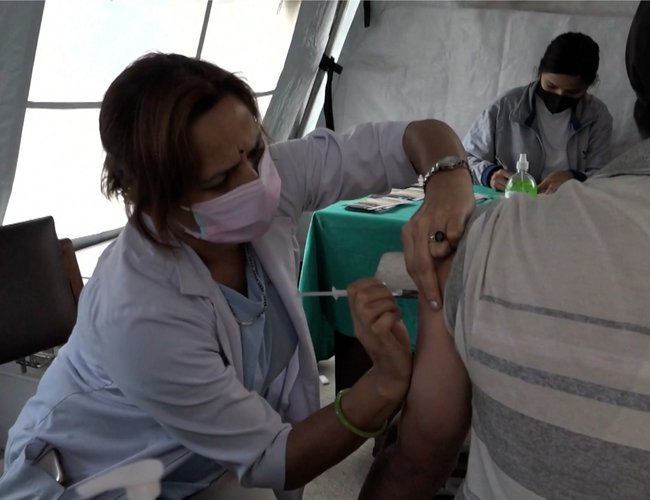
With the announcement of the United States of America to send 1.5 million doses of the Johnson & Johnson COVID-19 vaccine to Nepal, the common people, who have been waiting for vaccination, have heaved a sigh of relief.
Unlike other vaccines, J &J vaccine is a single dose vaccine to cover one and half million population. The shipments are part of the Biden administration’s pledge to share an initial batch of 80 million US-made vaccines globally.
Since the last seven decades, the United States has been part of establishment and expansion of health system in Nepal. Beginning from Malaria eradication to expansion of community based health system, mobilizing Female Community Health Volunters (FCHV), the United States has been providing technical and material support.
Besides, the United States has been providing emergency health and other support from time to time. The current announcement is also a part of continual support of the US government to Nepal.
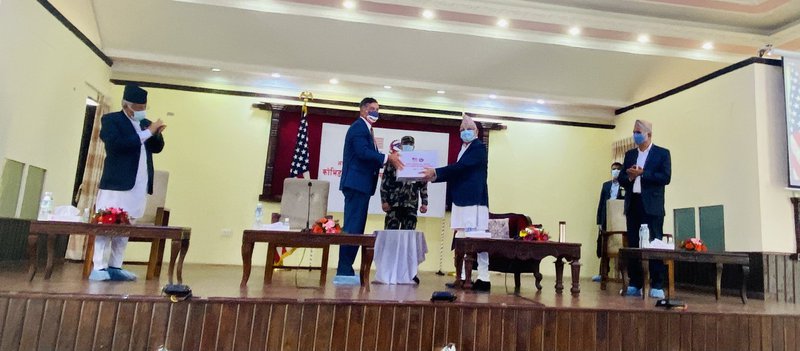
“We’re leading the world in a global vaccine strategy because it’s the right thing to do,” news agencies quoted a White House official as saying, “It’s the right thing morally, the right thing from a global public health perspective and right for our collective security and well-being.” The official also said that scientific teams and legal and regulatory authorities would work together to ensure prompt delivery of safe and effective vaccines to Nepal.
With this announcement of the United States, Nepal’s government authorities have also heaved a sigh of relief. At a time when 4 million doses of Vero Cell vaccines purchased by Nepal from China have already started to arrive, the new vaccines will help Nepal to accelerate the drive.
Uncertainty for Elderly
Despite the efforts made by Nepal through various channels, it is yet to be able to provide the second dose of vaccine to over 1.4 million people who had the first Covieshield vaccines.
They had received the first dose of the Covieshield vaccine almost 5 months ago. These 1.4 million people above 65 years are waiting for their second dose.
Frustrated by a long wait, the elderly people have started to express their anger through various means. However, the government looks helpless given the scarcity of vaccines.
“I was wondering, if there is any government in Nepal to take care of its citizens? Yes I found one for paying the medical bill of a political leader. What a government we have, when we all Nepalese are looking towards the International airport sky for COVID vaccine?,” Tweets Dr. Dwarikanath Dhungel, former secretary of Nepal. “As per today's some newspaper, Denmark has supplied million doses of Oxford/AstraZeneca vaccines to Bhutan under the grant program. Why Nepal has been completely forgotten? What went wrong to our diplomacy?”
Although Nepal started its vaccination drive, with generous support from Indian government, given the current global vaccine scarcity, it is uncertain whether they will get it or not. Under an interim order of the Supreme Court of India, the Indian government has completely banned the export of the Covieshield vaccine. Nepal had started vaccination to elderly people in March hoping to receive the necessary doses.
However, the deadly upsurge of the second wave of coronavirus has changed everything. The Indian apex court had in its order asked the government to administer vaccines to its citizen before exporting them to other countries.
Despite close relations, across an open border, the court’s order stopped the export of the Indian vaccine to Nepal and all other countries of the world.

Vero Cell Second Dose
Ministry of Health and Population (MoHP) has been providing a second dose of Vero Cell from July 6 and it is planning to start first doze to other age groups from 16 July. The country resumed its stalled COVID-19 vaccination campaign on June 8 with 1 million doses given by China after the government made international pleas for help with a shortage of shots.
Nepal has vaccinated about 14 percent of the population by July 10. Among them, 4 percent have received both doses and are fully vaccinated so far.
According to Dr. Jhalak Gautam, Chief of the National Immunization Program under the Ministry of Health and Population (MoHP), so far, 851,300 people have been vaccinated with their second dose of COVID-19 vaccine while 2.611 million have got their first dose in the country by July 9.
“An utmost effort from various mechanisms is underway to bring the vaccines,” said Dr. Gautam. “The government is committed to vaccinating all the eligible people free of cost and it has been exploring all possible ways to procure vaccines at the earliest.”
Among the people vaccinated with the first dose, around 1.4 million elderly citizens are eagerly waiting for the second dose of the vaccines. With the unavailability of vaccines, the government has not been able to inoculate them, which is necessary as a booster for better efficacy.
“The government had frequently made appeals to India to at least send the remaining 1 million Covishield jabs Nepal had paid for, and to Britain to supply vaccines so that elderly citizens could get the booster doses who are now waiting for more than 15 weeks.”
Dr. Rabindra Pandey, a public health expert, said that as the second wave of COVID-19 was more fatal than the first wave, people who have taken double shots have not fallen ill seriously from the virus.
Deaths were not recorded among the people who received both doses of the vaccine, said Dr. Pandey and emphasized the need to ensure availability of vaccines at the earliest.
Nepal launched its vaccination campaign against COVID-19 on January 27 with the 1 million doses India had provided under its Vaccine Maitri program.
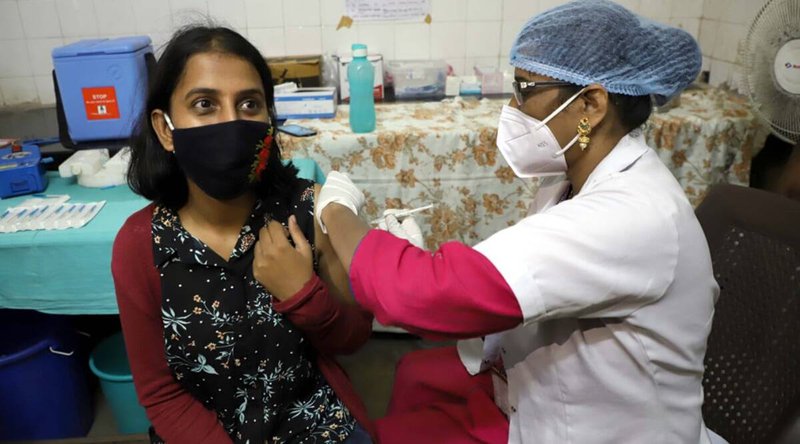
Second dose important, but no need to panic
As the country faces supply shortages of vaccines, those waiting for the second dose may have to keep waiting, but health experts say there is no need to panic.
According to Dr. Shyam Raj Upreti, Coordinator of the COVID-19 Vaccine Advisory Committee, when people take the first dose of any COVID-19 vaccine, it activates an immune response, which works even if you delay your booster dose.
Dr. Upreti said that the main concern in delays of the second dose may weaken immune response and one must get the second dose as soon as the vaccine becomes available.
He said that as the new strain of the virus is emerging time and again getting both doses is more important and safer.
Only one vaccine may not work at the optimum level, that is why people need the second dose, according to doctors.
In the case of the Covishield vaccine, the minimum gap between two doses is mentioned as 12 weeks but a longer gap could increase the results. Therefore, everyone must get his or her second dose of the COVID-19 vaccine even if it is delayed.
The unavailability of vaccines has sparked a wave of fear among the people, who got their first dose, but there is nothing to panic about, said Dr. Uprety and urged everyone to focus on getting their second dose as per the government schedule after availability of the vaccines.

Status of the vaccination campaign
Around 430,000 frontline workers – health workers, staff at health facilities, female community health volunteers, security personnel, sanitation workers – were listed as priority groups for the first round of the vaccination campaign.
After the first round’s first phase was completed, the government announced vaccination for journalists and diplomatic staff. When the first phase was completed on March 5, as many as 438,000 people had received their first dose of COVID vaccines.
In February, the government decided to buy 2 million doses of vaccines from the Serum Institute of India, at $4 per dose. The first consignment was delivered immediately, as 1 million doses arrived on February 21 but the second consignment has not arrived yet.
Also, 348,000 doses of Covishield arrived in Nepal on February 21 under the World Health Organization (WHO)’s COVAX facility. With the arrival of vaccines continuously, there were high hopes and the public responded heartrendingly. Then the government inoculated 1.4 million senior citizens in the second phase of the vaccination campaign.
After Nepal granted emergency use approval to the Vero Cell vaccine of Sinopharm on February 15, the Chinese government then provided 800,000 doses of the vaccine under the grant assistance. The Vero Cell arrived in Kathmandu on March 29.
After the arrival of the Chinese vaccine, the government resumed the vaccination campaign from April 7.
Vero Cell was then administered to people working in postal and telephone services, public transportation services, water supply and distribution, tourism sector—hotels and restaurants—production, sales and distribution of medicines, electricity supply, storage and transportation of consumer goods as well as health workers who had missed the first phase of the vaccination drive earlier from January 27. The government provided a second dose of Vero Cell from May 16 to May 25.
The country resumed its stalled COVID-19 vaccination campaign on June 8 with 1 million doses given by China after the government made international pleas for help with a shortage of shots.

Then the government decided to inoculate people aged 61-64. Having an insufficient amount of vaccines, some of the local levels provided jabs to people aged 62- 64 years of age.
Now, the Ministry of Health and Population (MoHP) has announced to launch the fourth found of vaccine campaign providing first dose of Vero Cell from July 16.
As per COVAX commitment, 1.9 million doses were to arrive in Nepal by March. However, as per the latest update made by the COVAX, an additional 348,000 could come by July.
Nepal Has Brought First Batch of 4 Million Vero Cell Vaccine Purchased from China
Over 809 thousand doses of Vero Cell, COVID-19 vaccine developed and manufactured by Sinopharm, have been brought to Kathmandu.
A wide body airplane, A 330, of the Nepal Airlines Corporation brought in a total of 17600 boxes of vaccine, in which a box had 46 doses of vaccine.
The vaccine has been purchased on the government-to-government (GtoG) basis. Some four million doses of Vero Cell are to be procured on this basis, and brought in.
According to the schedule published earlier, remaining vaccine will be brought in on July 15, July 16 and July 22.
Earlier, China had donated 2 million doses of Vero Cell to Nepal. Nepal had also received 348 thousand doses of vaccine under COVAX while India had also provided 1.8 doses of Covishield as assistance. 4.248 million Doses of COVID-19 vaccine have been brought in so far, according to the record of the Ministry of Health and Population.
With the arrival of vaccine from China and the US, Nepal is in a relatively better position to cover large sections of people to avoid third wave. As cases in India are declining and the production of vaccine rounds up, Nepal will be likely to receive more vaccine from India as well.
If things go as usual, Nepal will be in a position to vaccinate over 50 percent of population by the end of December.

Keshab Poudel
Poudel is the editor of New Spotlight Magazine.
- FOURTH PROFESSOR Y.N. KHANAL LECTURE: Nepal-China Relations
- Jun 23, 2025
- Colonel JP CROSS: Centenary Birthday
- Jun 23, 2025
- REEEP-GREEN: Empowering Communities with MEP
- Jun 16, 2025
- BEEN: Retrofitted For Green
- May 28, 2025
- GGGI has been promoting green growth in Nepal for a decade: Dr. Malle Fofana
- May 21, 2025





